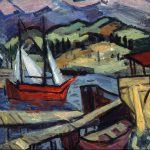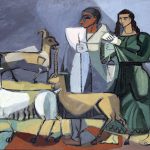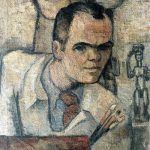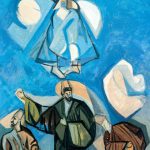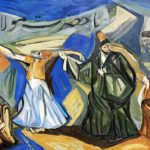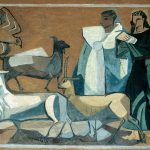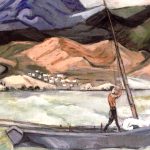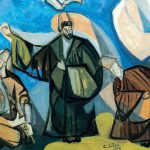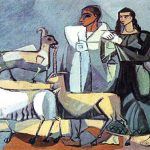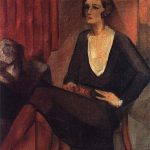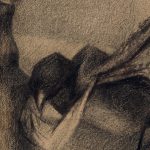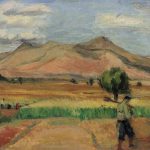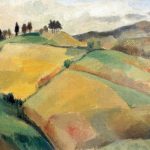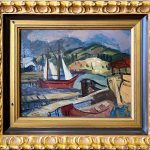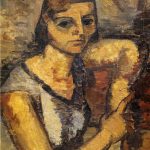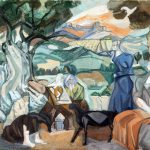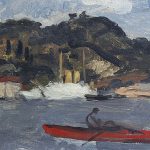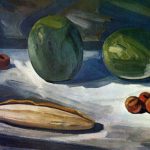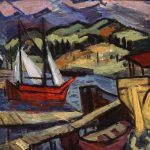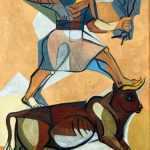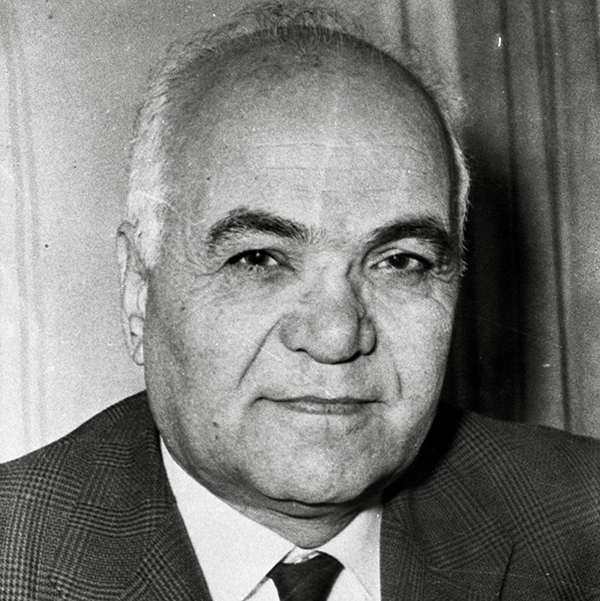
Who is Cemal Tollu?
He is one of the leading representatives of the 1930s generation. Tollu, who treats local subjects with a cubist approach in his paintings, is one of the D Group artists. His works are included in the Istanbul Painting and Sculpture Museum, the National Library Collection and many other official and private collections.
He was born on April 19, 1899 in Istanbul. He was the eldest child in a family of five children. His father is engineer Sait Bey and his mother is Hayriyet Hanım. He spent his childhood in Damascus and Diyarbakır due to his father’s work. He worked as an apprentice at Hejaz Railways. He took his first painting lessons from a retired kolağan during these years. He returned to Istanbul in 1919.
On his return to Istanbul, the artist enrolled in Sanayi-i Nefise Mektebi (Fine Arts Academy), but after Istanbul was invaded by the enemy, he had to take a break from his studies and attended the Zabit Namzetleri Training in Ankara. After the military training he received here, he was sent to the cavalry regiment in Konya in 1921 with the rank of cavalry lieutenant. He was discharged from the army in 1923 and worked as a wagon mechanic in Edirne between 1923 and 1925.
After the end of the Turkish War of Independence, he returned to Istanbul in 1926 and continued his education where he left off. Cemal Tollu, who completed his education as a secondary school art teacher, worked as a teacher in Elazığ and Erzincan until 1929, then went to Munich and Paris with the support of his family to improve his art. He spent a year in Europe between 1931 and 1932, working with famous artists such as Andre Lhote, Hans Hoffmann, Fernand Leger and Marcel Gromaire. While he was in Paris, he participated in the fourth exhibition of the Independent Painters and Sculptors Union with a portrait of a woman.
Upon his return to Paris, the artist was appointed as a teacher at Erzincan Military Secondary School, and he continued this duty until 1935. After returning to Turkey, Cemal Sait opened his first exhibition in Elazığ in 1932.
He was among the founders of D Group in 1933. The group opened its first exhibition at the Mimoza Hat Store in Narmanlı Han, at a venue arranged by the Beyoğlu District Governor, who is Tollu's relative. Cemal Tollu participated in all domestic and international exhibitions of the group.
In 1935, he worked as the director of the Anatolian Civilizations Museum (former name: Ankara Archeology Museum). During this period, he was influenced by the kunt forms of Hittite reliefs.
In 1937, he was appointed as Leopold Levy's assistant at the Academy of Fine Arts and went to Istanbul. He got married the same year. He worked as a mythology teacher and head of the painting department at the academy. The interest in mythology instilled in him by Ahmet Haşim while he was a student at the academy led him to publish a book called "Mythology" in 1957.
He turned to landscape paintings under the influence of having worked in Antalya and Burdur regions within the scope of 'Homeland Tours' organized by CHP since 1938. He went to Paris for the second time in 1939 and drew views of Paris. He also participated in the State Painting and Sculpture Exhibitions that started to be held in those years. He received the second prize with his work titled "Composition" in the 2nd State Painting and Sculpture Exhibition, and the first prize in painting with his work titled "Harvest" in the 21st State Painting and Sculpture Exhibition.
In 1954, he received the sixth prize in the painting competition themed "Production" organized by Yapı Kredi Bank for its 10th anniversary. He started working at the academy in 1937, where he served as a lecturer and department head until 1964. He retired from the State Academy of Fine Arts in 1964.
In addition to his painting, he was also a sculptor, but he did not create any works in this field except a few busts. However, his interest in sculpture influenced his paintings and played a role in the formation of his painting style. Tollu dealt with subjects specific to Anatolia in a cubist-constructive style in his paintings such as "Mother and Child", "Orange Garden in Hatay", "Ankara Goats and Harvest", which left a sculptural effect.
Tollu, who also worked as an art writer with his published articles, wrote his views on art in various publications, especially Yeni Sabah newspaper, in addition to his books on Greek Mythology (textbook) and Şeker Ahmet Pasha (monograph).
Among the artist's last works are "Beet Field" (1963, Istanbul Painting and Sculpture Museum), "Timar" (1964, in Ahmet Tollu), "Manisa Fire" (1964, Seyman Erkılıç col.), "Cotton Pickers I, II" (1964 - 65), "Pastirmaklar" (1965, Nevhız Pak col.), "Peasants and Sheep" (1965, Akbank col.), "Still Life Bodrum" (1966, Ahmet Tollu's). His works are included in the Istanbul Painting and Sculpture Museum, the National Library Collection and many other official and private collections.
Cemal Tollu died in Istanbul on July 26, 1968.
Some of his works
Naked with a Cat (1929)
Woman in a Black Dress (1930)
Seated Nude (1932)
Peasants reciting the alphabet (1933)
Portrait of a Teacher (1933)
Gray Sky (1937)
Fields (1937)
Entering Winter (1938)
Town on a Hill (1938)
Savarona (1938)
A Corner with Trees in Antalya (1938)
Tamarisk Tree (1938)
Two Trees (1940)
Harman (1941)
Country Coffee (1941)
Villagers Selling Cocoons (1943)
The Gypsy in the Red Dress (1943)
Woman with Braided Hair (1945)
Liberation of Manisa (1945)
Grape Harvesting in Ürgüp (1945)
Koza Inn (1949)
Battle of Gallipoli (1949)
Orange Garden in Hatay (1953)
The Shepherd and the Angora Goats (1955)
Mother Earth (1956)
Flesh Storm God (1956)
Mevlevis (1958)
Bodrum with Natürmont (1960)
Beet Field (1963)
Timar (1964)
Manisa Fire (1964)
Cotton Pickers I, II (1964-65)
Pastrami Makers (1965)
Peasants and Sheep (1965)
Bodrum with Still Life (1966)
